This Homemade Pizza Dough trial is a guest post from Anna Rider. Anna is a food writer who documents kitchen experiments on GarlicDelight.com with the help of her physicist and taste-testing husband Alex!
One of the easiest yeast doughs to make is pizza dough. But baking with yeast is terrifying so I tend to buy frozen pizzas and pre-made pizza crusts.
But after spending the last few weeks at home, a crazy idea surfaced in my mind.
What if I tried to make pizza from scratch?
Would it be worth it?
Only one way to find out. Mmm, I smell a homemade trial! Let’s find out what tastes better, homemade pizza dough or store-bought pizza crusts.
In case you’re new to the homemade trial series, Nick picks a food and makes it from scratch to compare it to a few popular store-bought versions in the categories of TIME, COST, NUTRITION, and TASTE.
After the controversial conclusion in the homemade trial on chocolate cake, I’m (Anna) back to run this homemade trial on pizza dough. Let’s jump in!
Anna’s Homemade Pizza Dough
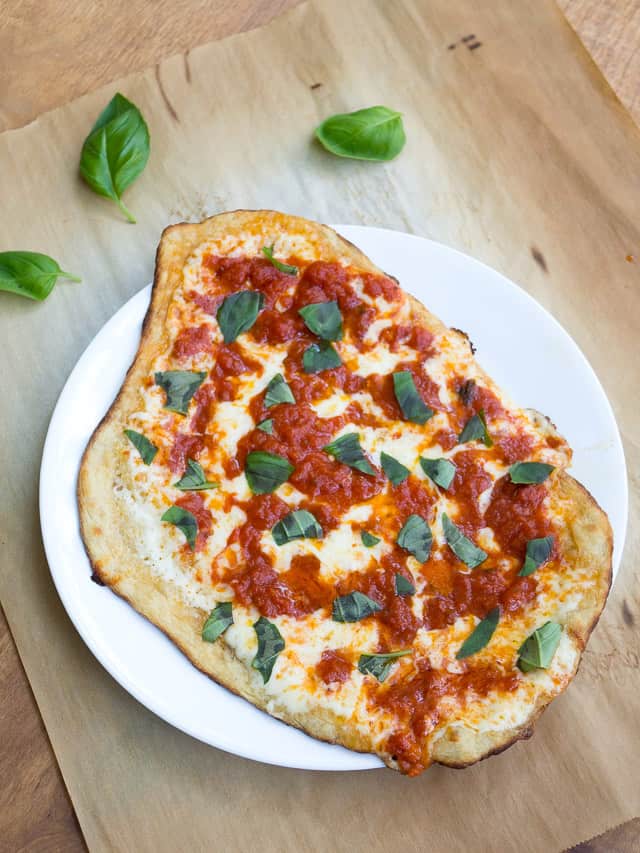
If you’re a longtime Macheesmo reader, you’ll know that Nick LOVES pizza. You’ll find many amazing pizza recipes in Nick’s Ultimate Guide to Homemade Pizza, including exotic pizza crusts using phyllo dough or semolina flour and techniques for tossing dough. Here’s a secret between you and me. I’m terrified of baking with yeast.
That’s why my homemade pizza dough recipe is simple and sticks to the basics. We’re talking water, flour, salt, and yeast with a pinch of sugar to jump-start the yeast.
The beauty of a simple recipe is that you’ve got all the ingredients to make this dough today. Plus you can make extra dough to freeze for later.
This recipe uses a food processor for kneading the dough. Read the end of the directions if you’d prefer to use a stand mixer or if you’re kneading by hand. Let’s dive in.
Homemade Pizza Dough for Beginners

Ingredients
- 1 to 1 ½ cups warm water, about 110ºF
- 2 teaspoons active dry yeast
- 1 tablespoon sugar
- 3 cups flour, plus extra for rolling out
- 1 ½ teaspoon salt
- 3 tablespoons olive oil, plus extra for greasing the dough and baking pan
Instructions
- Add 2 tablespoons of the warm water to the yeast in a mixing bowl. Add two pinches of sugar and mix until the yeast forms a rough paste. Leave the yeast in a warm area in the kitchen for 15 minutes. It should be frothy and continue to grow.
- Put the flour, salt, and olive oil into your food processor work bowl. Pulses a few times to combine. Add a cup of the warm water and the yeast. Turn on the food processor so that the blade mixes the ingredients until a rough, shaggy dough forms.
- Open the food processor and poke the dough. Note the dough’s texture and adjust with more flour or water.
- Turn on the food processor to knead the dough until it forms a smooth elastic ball. It is ready to rest.
- Move the dough to a big mixing bowl and cover the bowl with plastic wrap. Allow the dough to rise until it is at least twice the size. It might take 60 minutes in a warm kitchen or as much as 90 to 120 minutes in a chilly kitchen.
- Once your dough has risen to twice the size, divide the dough in half and shape into two balls. Lightly coat each ball of dough with olive oil to prevent the dough from drying out.
- Leave the dough to rest on a plate for 15 to 30 minutes covered with plastic wrap. If freezing, wrap the extra dough in plastic wrap and put it in a sealable plastic bag to store in the freezer.
- When you are ready to make the pizza, follow the directions on your pizza recipe to roll out the dough and bake.
- If you’re using a stand mixer, skip steps 2 to 4 and follow Nick’s instructions for making pizza dough in this. The quick summary is you combine all the ingredients and use the dough hook attachment to mix the dough for about 8 minutes. Then let the dough rest and follow steps 5 onwards.
- If you’re kneading with your hands, skip steps 2 to 4 and follow Nick’s instructions for making the dough in this. You need to mix the ingredients with a spatula until combined and then knead the dough by hand until the dough forms a ball with a smooth surface, about 10 minutes of kneading. Then let the dough rest and follow steps 5 onwards.
Nutrition
Did you make this recipe?
Tips for Making Homemade Pizza Dough
No recipe can tell you the perfect amount of water to add because it depends on your climate and the amount of moisture in your flour. In a humid climate, you will need less water. If it feels too sticky and clings to your finger, add a spoonful of flour and knead the dough. If it is too dry and crumbling, add a spoonful of the warm water. Keep adjusting spoonful by spoonful until your kneaded dough develops a smooth and elastic texture.
Resting is important to allow the gluten to form. I find that when I get impatient and try to roll out the dough before it is ready, it becomes stubbornly resistant and refuses to spread. If I force it, it leads to tears in the pizza crust, which results in sauce dribbling from the cracks when you bake your pizza. Not fun. So allow plenty of time for the gluten to relax.
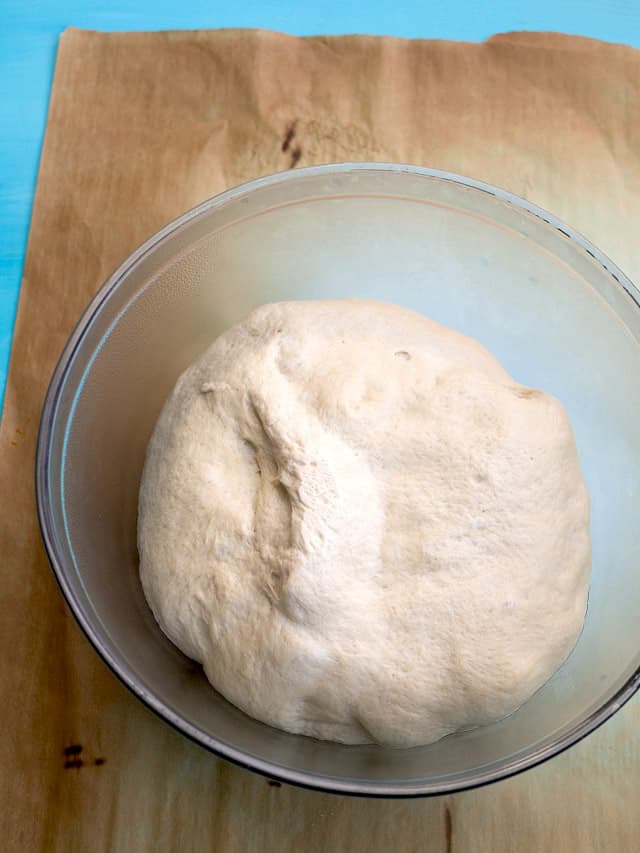
The Pizza Dough Competition
Wow, there are so many varieties of frozen pizzas at the grocery store that it makes you cross-eyed trying to keep track. It’s no different with plain pizza crusts and store-bought dough. Alex and I picked three contenders that represent the range of store-bought options: a frozen baked pizza crust, a freshly baked pizza crust, and store-bought raw pizza dough. Let’s see whether the ready-made crusts can beat our homemade dough.
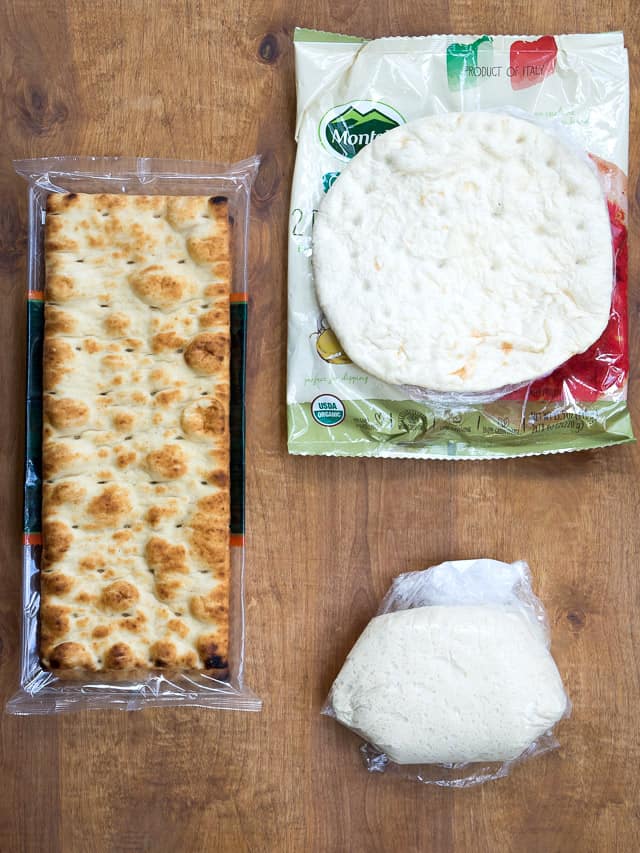
TIME
Making pizza dough at home isn’t so hard once you get the hang of it. But it requires planning and pockets of activity with plenty of resting time in between. The store-bought pizza crusts are ready to go, which saves you a lot of time, whereas the store-bought raw pizza dough instructions recommend leaving it for 20 to 30 minutes to get to room temperature.
No surprise, I’m going to consider it a WIN for the PRE-MADE pizza crusts in the category of TIME.
COST
Holy guacamole. Homemade pizza dough is a third of the price of pre-made pizza crusts and less than half the price of store-bought pizza dough. What’s amazing is that even during this time of flour shortages due to COVID-19, the elevated price of homemade dough is still much cheaper than store-bought dough.
What’s interesting is that the cost per serving increases as the pizza crust gets closer to its final baked, ready-to-eat form.
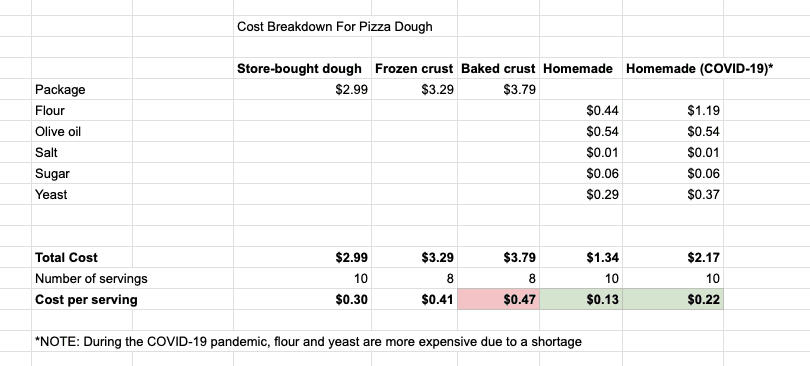
I’m going to have to give it to the HOMEMADE version in the COST category.
NUTRITION
I wasn’t holding my breath for many nutritional differences across the pizza doughs. Based on the nutrition comparison, it’s as we suspected. All four pizza crusts have comparable nutritional value. Maybe the store-bought dough has slightly less sodium but it’s barely a difference.
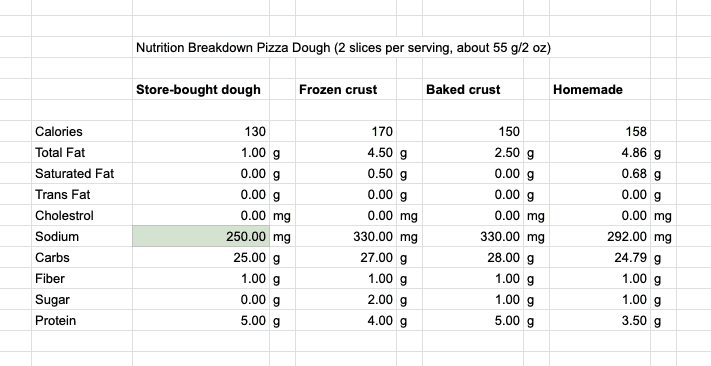
Unliked the hard-to-pronounce chemicals in the Betty Crocker cake from the homemade trial on chocolate cake, these store-bought pizza crusts have straightforward ingredients. The weirdest ingredients are ascorbic acid (vitamin C) used as a dough conditioner and malted barley flour, which adds extra sugar and protein to wheat flour making the dough softer and more caramelized.
I’m going to call the NUTRITION category a TIE.
TASTE
Ah, the most exciting part of the homemade trials. Which tastes the best?
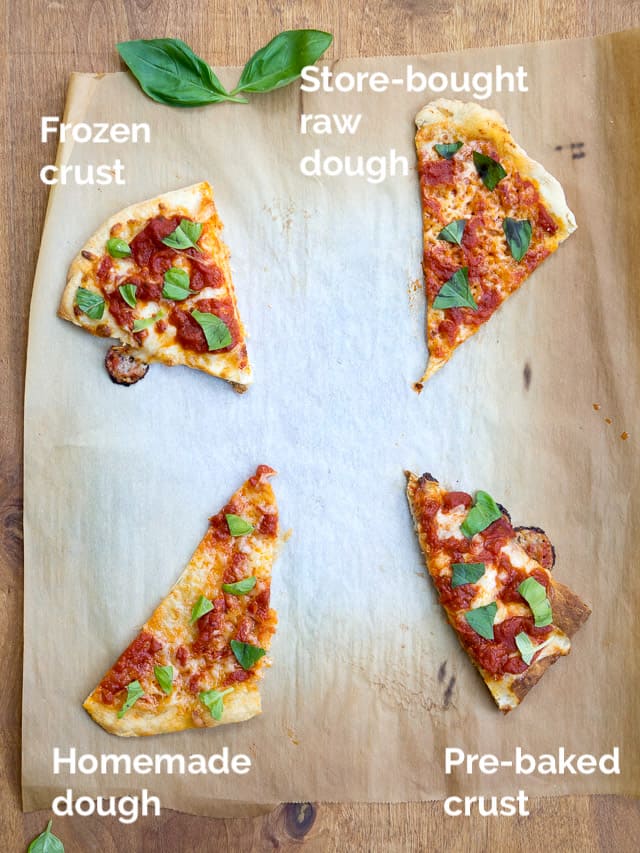
Pizza crusts taste test!
The first observation is that all the pizzas were delicious. So if you’re in a pinch and want to buy a pre-made pizza crust, go for it. You’ll still end up with a mouthwatering pizza that you can’t resist.
But let’s dig in to pick a winner. Alex’s favorite was the homemade pizza dough. He said it was the softest and chewiest and that’s the texture he likes. My favorite, surprisingly, was the store-bought dough. I liked how the crust was crispy and developed a beautiful golden brown coloring, probably thanks to the malted barley flour. That said, the store-bought dough was the hardest to roll out, and it developed bubbly holes which made the pizza sauce leak out so it was the messiest one to eat.
The pre-made baked crusts didn’t have the same soft or crispy texture. They were drier and harder, which was noticeable once you compared them to the pizzas made from raw dough.
I’m going to call this TASTE category a TIE between the homemade pizza dough and store-bought raw pizza dough.

The Verdict!
After this analysis (TIME => pre-made baked crusts, COST => homemade, NUTRITION => tie, TASTE => homemade and store-bought dough), here’s what I learned. Despite the time required, it’s worth it to make pizza dough at home. Considering the big cost savings and superior taste, homemade pizza dough is a no brainer.
But if you’re in a rush and don’t have a few hours to make pizza dough from scratch, store-bought raw dough is a perfectly delicious substitute for homemade dough. I bet I could tweak my dough recipe to add malted barley flour to make it crispier and golden.
You could also overcome the TIME factor by making extra pizza dough and freezing it. Then the homemade version would be unbeatable in all the categories.
What do you think? Are you nodding, unsurprised that homemade pizza dough won? Tempted to make pizza dough this weekend?



Matt Sanne
Nick, I’ve got a fool-proof pizza dough recipe (made with yeast though)… it’s been my go-to for the last 4 years! The heck with anything store bought… It makes legit thin-crust pizza, and can be ready in just over an hour, if you push it. Happy to share recipe, tips, pictures and videos!
Sammy
Looking for a good pizza recipe I’m getting ready to open up a pizza place
Nick
One hour?! Sounds awesome man. Would love to see the recipe!
John
Making pizza is easy but making a good pizza is not that simple :). Now I know you need to add yeast, sugar and salt while making pizza dough.